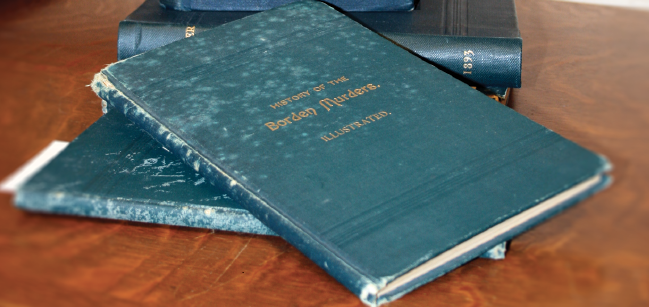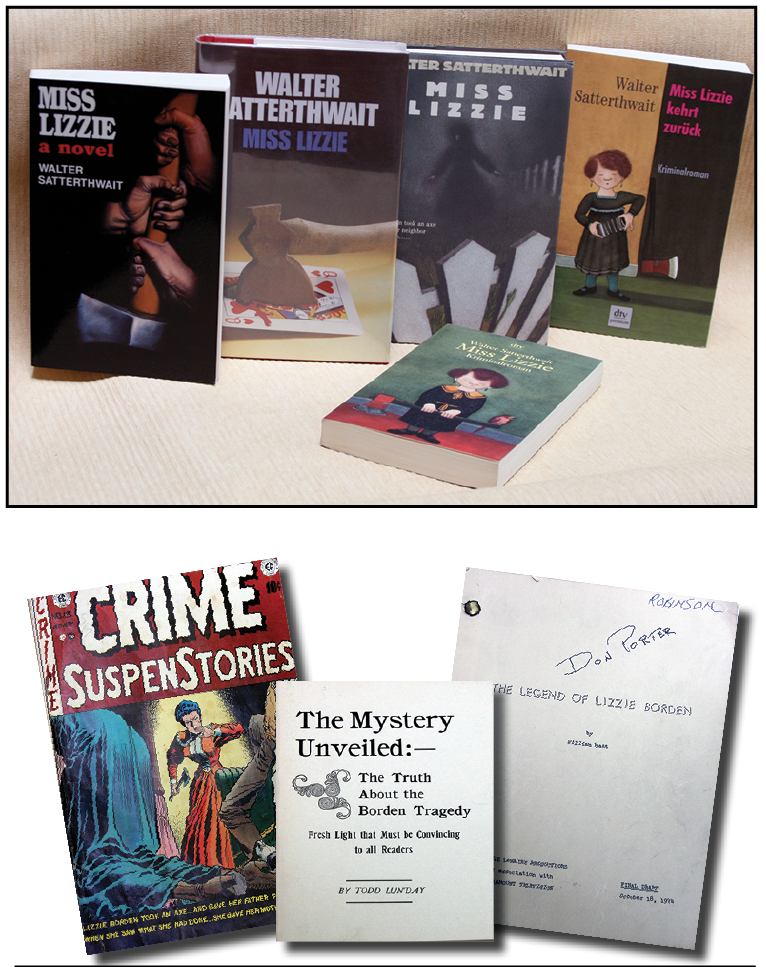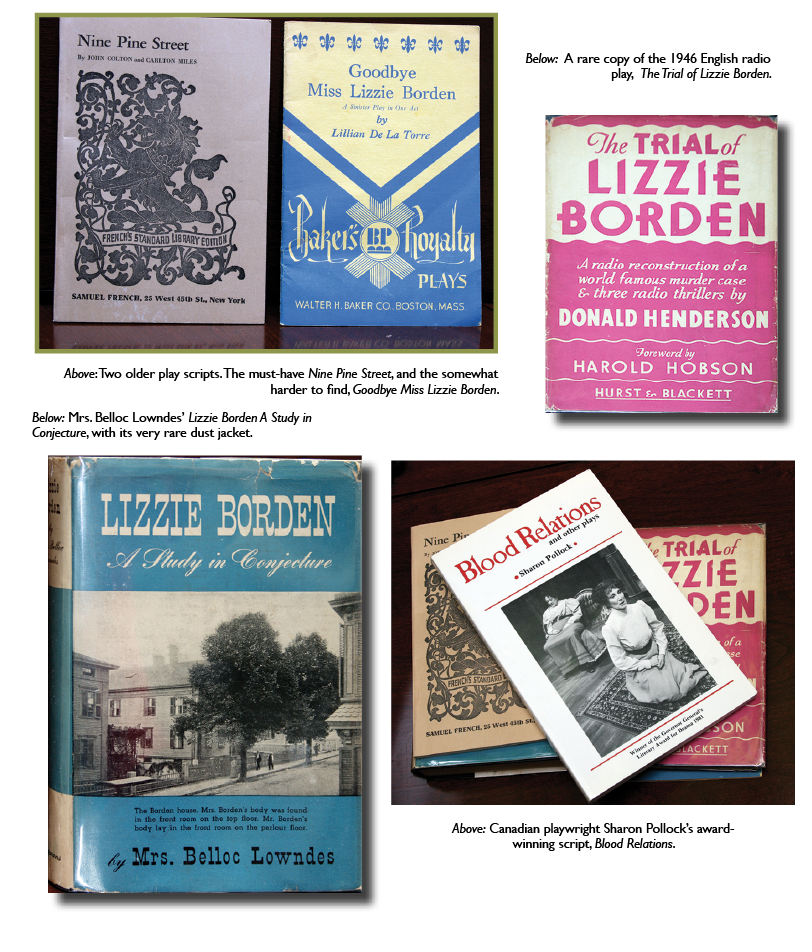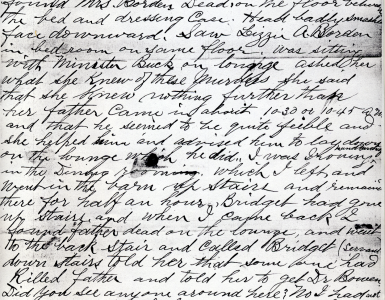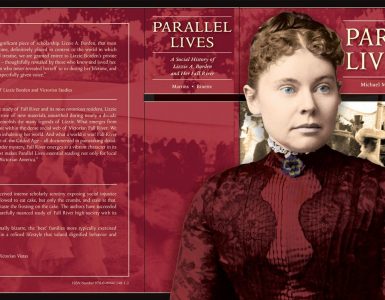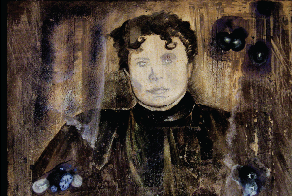by Michael Brimbau
First published in Spring, 2012, Volume 7, Issue 2, The Hatchet: Journal of Lizzie Borden Studies.
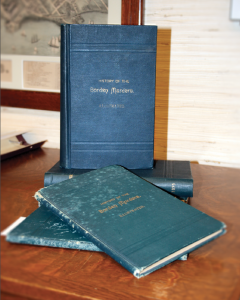
For the most part, collectors are born with the collecting gene. Ask any collector today and you will discover that when they were youngsters, they collected baseball cards, Beanie Babies, marbles, Hot Wheels, Barbie dolls, or some other sort of cherished paraphernalia. Chances are if you collected when you were a child, you are still at it as an adult.
The keys to successfully collecting anything are moderation, knowing your budget, and narrowing your field, common sense advice, which should go unsaid, but rarely practiced.
For some, collecting is more disease than passion. There is a fine line between Collector and Hoarder. Assembling one field can easily lead to another that has nothing to do with the essentials of the primary collection.
Let us say that your enthusiasm is collecting teapots. Soon you may find yourself accumulating teacups, creamers, sugar bowls or objects with the image of teapots on them, like postcards. Before long you are collecting postcards having nothing to do with teapots. Caught early, your misguided investment may be a small one. Fine-tune your repertoire. Consider your new trove as filler and return to the nucleus of the collection. Evidence that you are out of control as a collector is when you are ready to sell a collection and you find yourself still buying and adding to it right up to the very last day.
Never collect for an investment. No matter what you amass, when the time comes to sell, you may find that the market for your valuables has diminished or completely dropped off. Collect what you love for tangible and visual reasons, and because you love the item, not for monetary speculation.
Become an expert in the field that you collect and try to buy only the best and most desirable examples. Your mantra should be “quality before quantity.” An Art Deco Wedgwood Jasperware teapot will be treasured much more by collectors now and in the future than your grandma’s chipped Chintz Royal Doulton. A sterling silver Reed and Barton teapot, or an early sixteenth century Staffordshire will always be desirable and tickle one’s fancy, simply because there were few made and less on the market. But, if the time ever comes that you tire of your gems and wish to sell, quality will be your key to recouping most, if not all, of your investment.
Collecting, for me, started at ten years of age—with marbles. Not long after, I was fascinated with smooth, round beach pebbles. The more spherical the more precious, and perfectly round white stones (we called god rocks) were a prize indeed for a youngster, and satisfied the early collector’s high. I discovered early on that most of the pleasure of collecting was in the hunt.
Marbles I kept in pickle jars. Rocks and stones of all sorts lined my dresser. When I became a little older, I graduated to wood spinning tops. In my early teenage years it was model cars and planes and baseball cards and hats. By the time I had my own apartment I was collecting clocks—preferably late nineteenth century mantle and wall clocks. They had to be the “tick-n-gong” variety. It was a challenge to get them all to chime the correct time all at once. Clocks sat in every corner of every room. At the same time, I also collected old framed pictures of demure Victorian faces whose bugging eyes followed you everywhere you went. These old photos hung all over my apartment, to the objections of friends who were spooked by them.
Eventually, I graduated to collecting books on polar travel. Against the shrewd advice of a fellow collector, I did not narrow my field to a specific area of polar studies. It was not long before I had acquired a modest but expensive collection of all sorts of books about polar travel and exploration. I discovered that the theme was too vast and completing a collection in all polar areas was quickly draining my book kitty. It was almost impossible, given the number of books on the subject, to amass a complete assemblage. In time, I had limited my polar book collection to purchasing books only about the discovery of the North Pole. Now, instead of becoming a “jack of all trades and master of none,” my field of study made me an expert on the discovery of the North Pole. This gave the merit of my collection a more intellectual quality. Though I must confess, I have fallen off the wagon recently and started collecting books on the exploration of the Northwest Passage, so goes the rampant antics of a mad collector. Unlike completing a collection on polar studies, considering the number of books about the Borden case, completing a collection on Lizzie Borden studies is a piece of cake in comparison.
At the same time, and with my collecting juices flowing, I began obtaining books about Fall River, Massachusetts and its history; soon it was books written by Fall River authors. One such example was a small volume by Alvin Weeks about Massasoit, Sachem of the Wampanoag Indians of Southeastern New England. Published in 1919, Massasoit sat on my shelf begging me to collect books about the New England Indian Wars, which I did. Ultimately, I stumbled upon books about the Borden murders. Here, I tried my best to collect just books about the crime. The world of Lizzie contained all manner of collectables—dolls, plates, paperweights, newspapers, folk art, tee shirts, jewelry, clocks and many, many other items. I did my best to narrow my collection to books only, but even here I must confess to a Lizzie plate or two.
Collecting Books on the Borden Murders
When it comes to collecting books about the Borden case, the cornerstone of any collection is a first edition of Edwin Porter’s book, The Fall River Tragedy, A History of the Borden Murders, printed in 1893. The copy in my collection was discovered at a book show on Cape Cod in 1985. Not long ago, it was thought that only three or less printings of Porter’s book had survived, this on the heels of the legend that Lizzie Borden had purchased the entire publication and had them destroyed. Today, we know this is not true. I learned early on through book dealers and by attending book shows that “they were out there.” Since the purchase of my personal Porter in 1985, I have handled, at the very least, twelve of the 1893 editions, and have witnessed many more for sale through local bookshops, auctions, and eBay listings.
While I consider an 1893 Porter a must-have, Todd Lunday’s little book, The Mystery Unveiled: The Truth About the Borden Tragedy, 1893, is more prized because it is the rarest title on the Borden murders. More of a pamphlet than a book, it is only 56 pages long. I have only seen two in my thirty years of collecting—both of them in private hands. There is also one at the Fall River Historical Society and another Lizzie collector tells me that she knows of one in still another private collection. It is truly a rare item. If one can consider Edwin Porter’s tome the cornerstone to a Borden collection, then Todd Lunday’s little paperback is surly the foundation.
For those thinking of investing in a Borden book collection, below is a list of books making up what can be considered a healthy collection.
Edwin Porter, 1893, The Fall River Tragedy: A History of the Borden Murders (First book written on the Borden murders.)
Robert A. Flynn, 1985, The Fall River Tragedy: A History of the Borden Murders (Second edition, reprint of the 1893 first edition and an excellent substitute.)
Todd Lunday, 1893, The Mystery Unveiled: The Truth about the Borden Tragedy: Fresh Light That Must Be Convincing to All Readers (Extremely rare. Chances of acquiring one are very difficult, and if one comes up on the market, it could sell for $2,000-$3,000, or more.)
Robert A. Flynn, 1990, reprint of the Todd Lunday title above (An exact copy, well done.)
Leonard Rebello, 1999, Lizzie Borden: Past and Present (Borden bible.)
Michael Martins, Dennis Binette, 1994, Commonwealth of Massachusetts vs. Lizzie A.
Borden, The Knowlton Papers 1892-1893
Michael Martins, Dennis Binette, 2010, Parallel Lives: A Social History of Lizzie A. Borden and Her Fall River (Must-have with tons of new information. The book is developing a reputation for exposing the real Lizzie Borden.)
Edmund Pearson, 1937, The Trial of Lizzie Borden (First critical study of the crime, after Porter.)
David Kent, 1992, The Lizzie Borden Sourcebook (The crime through newspaper accounts.)
Harry Windows, Stefani Koorey, Kat Koorey, 2005, The Trial of Lizzie Andrew Borden, 3 vols.
Harry Windows, Stefani Koorey, Kat Koorey, 2005, The Preliminary Hearing in the Lizzie Borden Case
(The trial and preliminary transcripts are original testimony and a must-have for those wanting to be taken seriously when debating the Borden murders.)
Charles and Louise Samuels, 1953, The Girl in the House of Hate: The Story and All the Facts of the Lizzie Borden Murders (Paperback copy, first edition. Collectable artwork on cover.)
Marie Belloc Lowndes, 1939, Lizzie Borden: A Study in Conjecture (Jacket is almost more valuable than the book itself. Try to find a copy with dust jacket, if possible. It is a work of fiction.)
In addition to the titles above, we cannot forget the “gang of six.” Some of these authors endeavor to tell it like it is, but others could not help but add some critical supposition or naked speculation. Each of them adds their own twist. David Kent is probably the most accurate. Writers such as Spiering, Lincoln, and de Mille take liberties, contort, and shape the truth just enough to be believable. They are listed in the order of the year they were published:
Edward Radin, 1961, Lizzie Borden: The Untold Story
Victoria Lincoln, 1967, A Private Disgrace: Lizzie Borden by Daylight
Agnes de Mille, 1968, Lizzie Borden: A Dance of Death
Robert Sullivan, 1974, Goodbye Lizzie Borden
Frank Spiering, 1984, Lizzie: The Story of Lizzie Borden
David Kent, 1992, Forty Whacks: New Evidence in the Life and Legend of Lizzie Borden
One cannot give mention to these titles without introducing a book that stands by itself. The author’s synopsis can only be described as radical, when compared to his fellow writers. Though not a book of fiction, some think it reads that way, since his summary is so contentious and dissimilar. He sounds like he knows what he is talking about. But, a close study exposes a series of holes and loose ends. Still a good read, though some who dislike Brown’s book would tell me to keep my opinion to myself.
Arnold Brown, 1991, Lizzie Borden: The Legend, the Truth, the Final Chapter
In his book, Brown chases the unlikely scenario that Borden’s illegitimate son, William Borden, killed Andrew and Abby Borden. Though a William Borden did exist at the time, there is no proof that Andrew Borden fathered a love child, but after reading Brown, you may think differently.
A Borden collection would not be fulfilled without a few examples of plays about Lizzie. The most famous theatrical work is by John Colton and Carlton Miles, based on a play by William Miles and Donald Blackwell, called Nine Pine Street, published seven years after Lizzie’s death. In the play, all of the real names have been changed. Lizzie is known as Effie Holden and Emma, Clara Holden. On stage, Lillian Gish played Effie. The original play opened on Broadway in late April of 1933. After a dismal 28 performances, sadly, it closed by the end of May of that year. But the Samuel French publication of the play, printed in 1934, is still with us, and can be had for around $25 to $40. If not the first, it is certainly one of the earliest appearances of the Borden story produced for the stage. Though not rare, it is unquestionably scarce. As of this writing, I could only find two for sale online.
Another rare play you may want to collect is Goodbye Miss Lizzie Borden: A Sinister Play in One Act, by Lillian de la Torre. The actual book is a thin pamphlet only 38 pages long. This tiny publication was produced twice for television. Performed with de la Torre’s original title, it first appeared on the Actor’s Studio in 1948. Actor’s Studio was a theatrical drama on television and aired for two seasons, between 1948 and 1950. In 1956, Alfred Hitchcock produced the play and changed the title to The Older Sister, where it aired on the Alfred Hitchcock Presents series.
A handful of older plays to collect would be:
John Colton and Carlton Miles, 1934, Nine Pine Street, a Play in Three Acts and Epilogue
Donald Henderson, 1946, The Trial of Lizzie Borden (British production made for radio)
Lillian de la Torre, 1947, Goodbye Miss Lizzie Borden: A Sinister Play in One Act
Reginald Lawrence, 1958, The Legend of Lizzie: A Play in Two Acts
Tim Kelly, 1976, Lizzie Borden of Fall River: A Drama in Two Acts
A small number of more recent plays are:
Owen Haskell, 1993, Lizzie! A Play In Two Acts
Marjorie Conn, 2002, Miss Lizzie Borden Invites You to Tea from Lost Lesbian Lives
Nick Pelino Jr., 2007, Lizbeth of Maplecroft
Sharon Pollock, 1981, Blood Relations
As a collector of books in general, not only books on the Borden case, I must give my kudos to Owen Haskell’s publication, Lizzie! A Play in Two Acts. As a tangible item it is a class act. Published by the Lazrus Press in 1993, it was issued in a nice red hardcover with dust jacket. Also issued was a limited edition of 150 copies, housed in a burgundy red slipcase, and signed by Haskell, and another limited to 26 lettered copies. This is a gratifying publication with a storyline that promises to delight.
The list above is just a plinth for starting a book collection on the Borden murders. Your preferences may differ. There are many, many more titles to collect, including books that are compendiums on murder, which include a chapter on the Borden case. Along with these are magazines, periodicals, and even comic books about the Borden affair. To those authors I did not list, my humble apologies.
Keep in mind, when collecting, condition is imperative, but an exceedingly rare 1893 Todd Lunday in almost any condition would be acceptable. One must also be a little more forgiving when collecting nineteenth century books such as Edwin Porter’s title. When issued, dust jackets must be included and in very good condition, with the exception of Marie Belloc Lowndes’ book, Lizzie Borden: A Study in Conjecture. Copies of Lowndes’ book with dust jackets are scarce, but out there. Don’t hesitate to purchase a copy without jacket. It may be a while before you find one with a jacket that is affordable. I purchased one just last week for $60, with dust jacket. Luck! On abe.com, there are four copies as of this writing. The least expensive copy was listed for $66, without a dust jacket. The dealers for two others are asking $75 and $100, both copies without dust jackets. Also listed on the same site is one signed by Marie Belloc Lowndes with dust jacket in great condition for $750.
A couple of years ago, I was fortunate enough to purchase a couple of books from Lizzie Borden’s personal library. These were titles that sat in her library at Maplecroft, her home after the trial. What gave these books great value and the necessary provenance was that Lizzie’s handwriting appeared on the first free endpaper. Lizzie had a custom of initialing her books with the letters “L.A.B.” or including a decorative insignia sticker of the letter “B” for Borden. Very few of these volumes have hit the book market. The Fall River Historical Society has many fine examples of books from Lizzie’s library. More can be found at the Lizzie Borden Bed and Breakfast. Five additional copies sit on a shelf in my personal library. I consider them as pivotal stanchions, propping up the lesser titles in my collection.
A Rare Find
Several weeks ago, I was lucky enough to discover, bid, and win a very rare Borden book, and a great addition to my Lizzie book collection. The listing for the item was posted on eBay. It was a salesman’s copy of Edwin Porter’s book, The Fall River Tragedy. In all my years of collecting, I have never observed one for sale. A salesman’s dummy of a highly sought after author holds great value, and often more than the genuine book itself. An example of this is Mark Twain’s Following the Equator, first published in 1897. First editions of this title, in respectable condition, can be had for $300-$400. A salesman’s sample of the same book will list for $1,500, or more. This is because there were very few of them printed. With The Fall River Tragedy, the only copies I know of exist in the library of the Fall River Historical Society. Until another surfaces, which may be highly unlikely, the copy I purchased may be the only one in private hands. Though a very bold declaration, it may not be far from the truth. It is a highly collectable Borden item indeed.
A salesman’s copy was a thinner sample of the original book. Sometimes called a Salesman’s Sample or Publisher’s Dummy, they were carried door to door by bookmen promoting a title before, or during, publication. This practice was known as buying a book through subscription, and was common practice during the late nineteenth century. A salesman’s sample usually included a small number of pages, giving the buyer a notion of what the final publication would look like and lending to the general theme of the book. Most examples had a group of blank pages at the end so the salesperson could write in names and addresses of customers and subscribers. Unlike books today, at the peak of the Victorian era, many were published in both cloth and leather. On a salesman’s dummy, the outside cover may have been cloth, but when opened had another cover inside in leather. Early books were also published in assorted cloth colors and the salesman’s copy may display examples of them inside as well. Also included in these faux bindings were examples of the final spine, along with any title or illustration they may contain. A collector interested in the binding or printing field may collect books about bookbinding and include salesman’s samples as part of their collection.
Though the first edition of Porter’s book contains 312 pages, the salesman’s copy has only 48. The binding and boards are duplicates of the actual volume. On the back cover is an illustrated example of the spine. What adds further value to the salesman’s facsimile of Porter’s book is that it displays a rare portrait of Andrew Borden as a frontispiece. It was believed that complaints filtered down from the Borden family, either from Lizzie or her sister, Emma, about using the portrait of Mr. Borden. When the book was issued in 1893, the likeness of Andrew Borden was excluded and does not appear in the final published version of the book.
For those wishing to begin a Borden collection right away, and wanting to start at the top, here is a very desirable copy. It is listed online. It is the only one I could discover for sale at the present time. It is a copy of Edwin Porter’s 1893 book The Fall River Tragedy, and is being sold by an English bookseller in the United Kingdom.
This specific title of Porter’s book comes with a little provenance, which makes it very unique indeed. This copy once belonged to a Fall River native with a connection to the case. Inside is an inscription gifting the book to a David Homes with compliments of David P. Keefe. Keefe was a letter carrier who lived on Elm Street in Fall River in 1892, and was hired by Lizzie Borden’s uncle, John Morse, to bury the bloody clothing of Andrew and Abby Borden. Keefe also helped search the barn with Uncle John Morse to assist in search of evidence. It is certain that Morse solicited Keefe to get rid of the bloody clothing of Abby and Andrew Borden. The clothing was known to even contain some bone fragments from one of the victims. Local newspaper accounts dated August 6 had the story that Keefe wanted five dollars to bury the clothing. Morse refused and in the end Keefe settled for three. Later they were forced to unbury the clothing by the medical examiner William A. Dolan who insisted that they be saved.
The bookseller is asking $1,654.49. It is little pricey, but a nice copy indeed. A fair market value for Porter’s book in this condition can be anywhere between $650 to $1,200, with most selling with an average price of around $1,000. The only copy of the book I know which exists with an association provenance is in the library of the Fall River Historical Society, and once owed by Charles Holmes, a close friend of the Borden family. When one considers the rarity of Porter’s book and the lack of signed or association copies, it is a very cravable copy.


